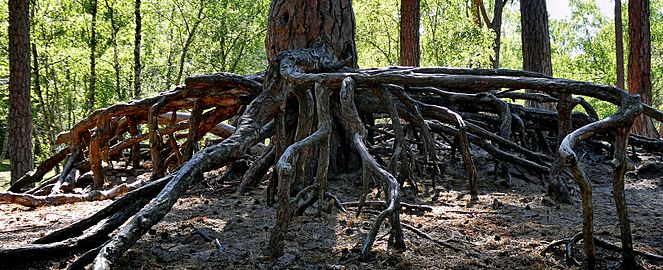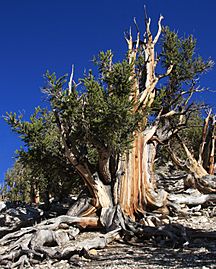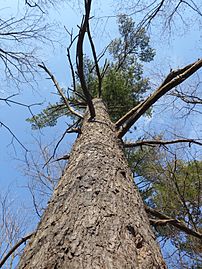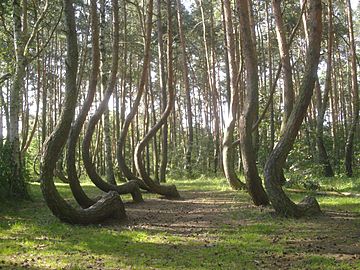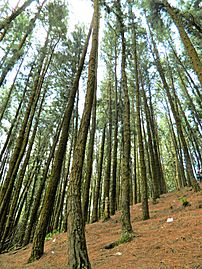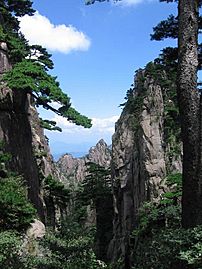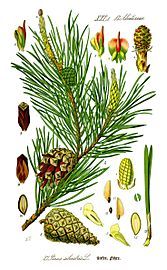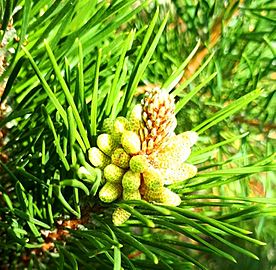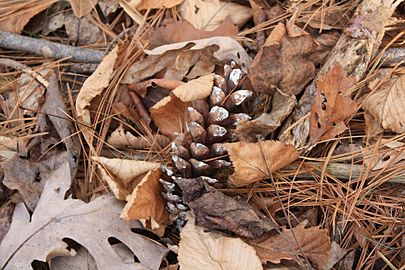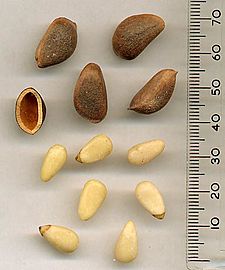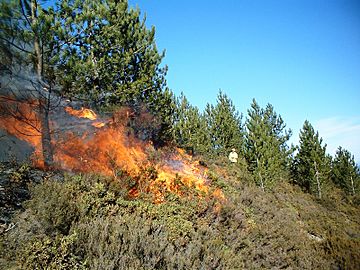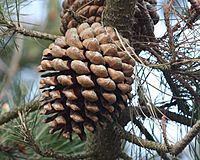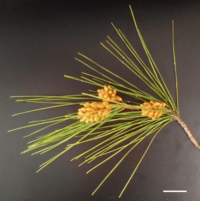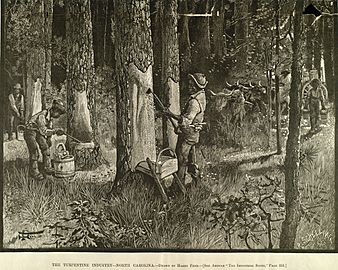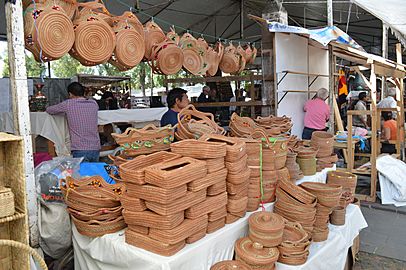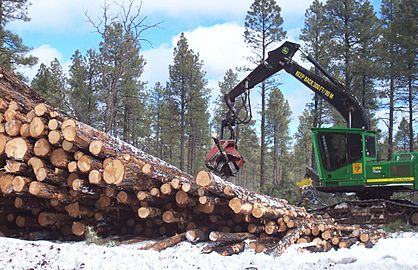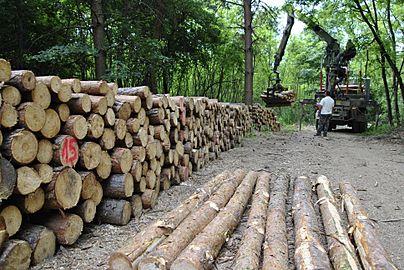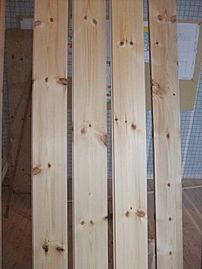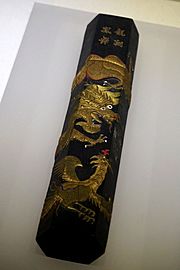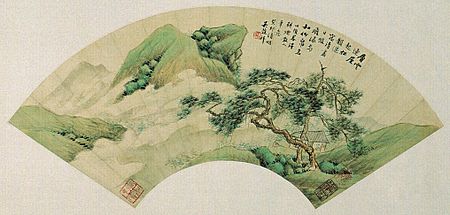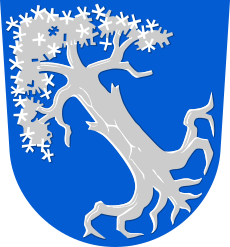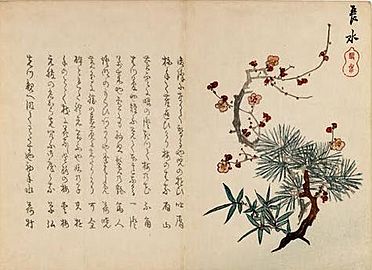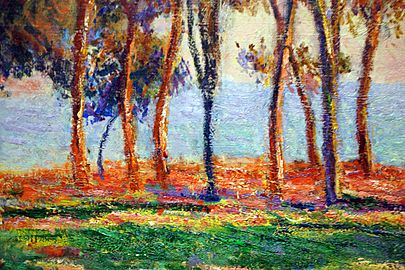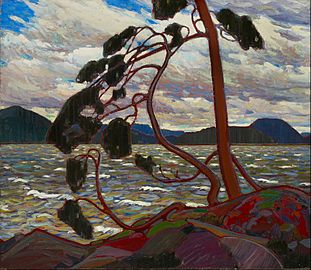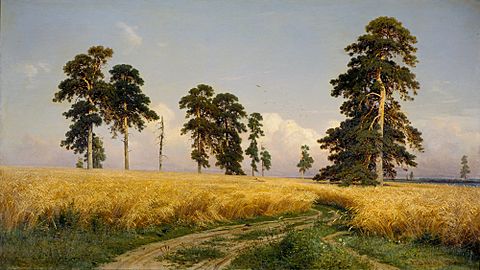Pine facts for kids
Quick facts for kids Pine |
|
|---|---|
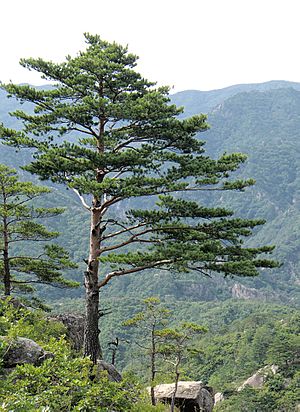 |
|
| Pinus densiflora (Korean red pine), North Korea | |
| Scientific classification |
|
| Kingdom: | Plantae |
| Clade: | Tracheophytes |
| Division: | Pinophyta |
| Class: | Pinopsida |
| Order: | Pinales |
| Family: | Pinaceae |
| Subfamily: | Pinoideae |
| Genus: | Pinus L. |
| Type species | |
| Pinus sylvestris |
|
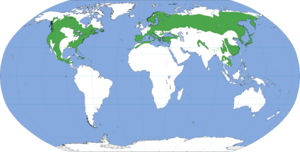 |
|
| Range of Pinus | |
A pine is a type of conifer tree or shrub that belongs to the genus Pinus. This genus is part of the family Pinaceae. Pines are the only type of tree in their special group called Pinoideae.
Experts at the Royal Botanic Gardens, Kew and Missouri Botanical Garden say there are 187 different kinds of pines. Other groups, like the American Conifer Society, recognize about 121 species. Pines are usually found in the Northern Hemisphere. The word "pine" can also mean the wood that comes from these trees. Pine wood is one of the most used types of wood in the world. The pine family is the biggest conifer family, with many different types grown for various uses. Pines are also a popular choice for Christmas trees!
Contents
What Do Pine Trees Look Like?
Pine trees are evergreen trees, which means they keep their green needles all year round. They are also conifers, meaning they produce cones. Most pines are trees, but some are shrubs. They can grow from about 3 to 80 meters (10 to 260 feet) tall. Most species reach 15 to 45 meters (50 to 150 feet) tall. The smallest pines are the Siberian dwarf pine and Potosi pinyon. The tallest known pine is an 81.8-meter (268-foot) tall ponderosa pine in Oregon, USA.
Pines can live for a very long time, usually from 100 to 1,000 years. Some live even longer! The oldest known pine is the Great Basin bristlecone pine. One of these trees, named "Methuselah", is about 4,800 years old. It grows in the White Mountains of California. Another bristlecone pine, which was cut down, was found to be 4,900 years old. It was called "Prometheus".
The way pine branches, needles, and cones grow often follows special patterns called Fibonacci numbers. New shoots in spring are sometimes called "candles". They are covered in brown or white scales and point upwards at first. Later, they turn green and spread out. Foresters can use these "candles" to check how healthy the soil is and how strong the trees are.
-
Roots of an old pine in Ystad, Sweden (2020)
-
Ancient Pinus longaeva, California, US
-
A large eastern white pine (P. strobus) in Southern Ontario, Canada
-
A Khasi pine in Benguet, Philippines
-
Crooked Forest in Nowe Czarnowo, Poland
-
Pine forest in Vagamon, southern Western Ghats, Kerala (India)
-
Huangshan pine (Pinus hwangshanensis), Anhui, China
-
Illustration of needles, cones, and seeds of Scots pine (P. sylvestris)
-
A growing female cone of a Scots pine on a mountain in Perry County, Pennsylvania
-
A fully grown and freshly fallen female pine cone (P. strobus)
-
Seeds of the Korean pine (P. koraiensis)
-
A controlled burn in a European black pine (P. nigra) woodland, Portugal
Pine Bark
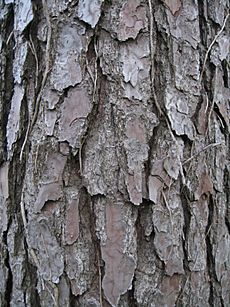
The bark of most pine trees is thick and scaly. However, some types have thin, flaky bark. Pine branches grow in regular "whorls," which look like rings of branches coming from the same spot. Many pines grow one whorl of branches each year. Other pines can grow two or more whorls per year.
Pine Needles (Foliage)
Pines have four main types of leaves:
- Seed leaves: These are the first leaves on a young seedling. They grow in a circle.
- Juvenile leaves: These appear after the seed leaves on young plants. They are usually 2–6 cm long and arranged in a spiral. Pines produce these for six months to five years.
- Scale leaves: These are small, brown, and not used for making food. They are like bud scales.
- Needles: These are the adult leaves. They are green and used for photosynthesis. Needles grow in small bundles called fascicles. Each bundle can have one to seven needles, but usually has two to five. Needles can stay on the tree for 1.5 to 40 years, depending on the pine species. If the growing tip of a branch gets damaged, the needle bundles below the damage can grow a new stem. This helps the tree replace the lost part.
Pine Cones and Seeds
Pines are monoecious. This means they have both male and female cones on the same tree. Male cones are small, usually 1–5 cm long. They are only present for a short time, usually in spring, to release their pollen. After releasing pollen, they fall off.
Female cones take 1.5 to 3 years to fully grow after pollination. Each cone has many scales arranged in a spiral. Most scales have two seeds. The scales at the bottom and top of the cone are small and don't have seeds.
Most pine seeds are small and have wings, so the wind can carry them away (wind-dispersed). Some seeds are larger and have only a tiny wing. These are spread by birds. Female cones are woody and sometimes have sharp points to protect the seeds inside from animals. When the seeds are ready, the cones usually open up to release them.
In some types of pines, like the whitebark pine, birds have to break the cones open to get the seeds. Other pines store their seeds in closed cones for many years. These cones only open when a special event happens, like a forest fire. This is called serotiny. For example, in the P. rigida, a sticky resin holds the cones shut until the heat from a forest fire melts it. Then the seeds are released.
Where Do Pines Grow?
Pines are native to the Northern Hemisphere. They also grow in a few parts of the tropics and temperate areas in the Southern Hemisphere. Most regions in the Northern Hemisphere have some native pine species. One type, the Sumatran pine, grows just south of the equator in Sumatra. In North America, pines grow from as far north as 66°N to as far south as 12°N.
Pines can be found in many different environments. These include dry deserts and rainforests. They grow from sea level up to 5,200 meters (17,000 feet) high. They can also live in the coldest and hottest places on Earth. Pines often grow in mountains where the soil is good and there is some water.
Many pine species have been brought to other parts of the world. People grow them for timber or as ornamental plants in parks and gardens. Some of these introduced pines have started growing on their own in new areas. A few have even become invasive, meaning they spread quickly and can harm local plants and animals.
How Pines Interact with Nature
Pines grow well in acidic soils. Some can also grow in soils with limestone. Most pines need soil that drains water well, preferring sandy soils. However, a few types, like the lodgepole pine, can grow in wet soils that don't drain well. Some pines, like the Canary Island pine, can grow back after forest fires. Other pines, such as the bishop pine, actually need fire to help their seeds sprout and grow. If there are no fires, their numbers slowly decrease.
Pine trees are good for the environment because they can remove carbon dioxide from the air. However, some studies show that when pine forests are planted in grasslands, the amount of carbon in the soil can decrease.
Several pine species are able to live in very harsh conditions. These include high mountains or very cold places. Examples are the Siberian dwarf pine and the bristlecone pines. Other pines, like the pinyon pines and Turkish pine, are very good at growing in hot, dry, semi-desert climates.
Pine pollen is important for the tiny creatures that break down dead plants and animals. Nutrients from pollen help these creatures grow and develop. Pollen can also help fungi break down tough plant material. Pine pollen also helps move plant matter between land and water ecosystems.
Wildlife and Pines
Pine needles are a food source for many types of Lepidoptera (which are butterflys and moths). Some of these moths only eat one or a few types of pine. Several pine species can be attacked by tiny worms called nematodes. These can cause a disease that quickly kills the trees.
Many birds and mammals find shelter in pine forests or eat pine nuts. The seeds are often eaten by birds like grouse, crossbills, and squirrels. Some birds, like the Clark's nutcracker, are very important for spreading pine seeds to new areas. Pine needles are sometimes eaten by insects called sawflies and by goats.
How People Use Pine Trees
-
A picture portraying the turpentine industry
-
Logging Pinus ponderosa, Arizona, US
-
Pinus sylvestris prepared for transport, Hungary
-
Tongue and groove flooring of solid German pine
Pine Wood for Building
Pines are very important trees for their timber and wood pulp all over the world. In many regions, they are fast-growing softwoods. They grow closely together, and their acidic needles help stop other types of trees from growing nearby.
Pines grown for commercial use produce wood that is stronger and lasts longer than spruce wood. Pine wood is used for many valuable carpentry items. These include furniture, window frames, wall panels, floors, and roofing. The resin from some pines is also a key source of turpentine.
Pine wood does not naturally resist insects or decay after it's cut. So, if it's not treated, it's usually only used for indoor building. For outdoor use, pine needs to be treated with special chemicals to protect it.
Pine Trees for Decoration
Many pine species are beautiful plants for parks and large gardens. There are also smaller types that fit well in smaller spaces. Pines are also grown and cut down to be Christmas trees. Pine cones are the largest and strongest of all conifer cones. They are popular for crafts. Pine branches, especially in winter, are loved for their nice smell and green color. People often cut them for decorations.
Pine needles are also used to make decorative items like baskets and trays. During the U.S. Civil War, people widely used the needles of the longleaf pine for this. This skill originally came from Native Americans and is now done around the world. Pine needle crafts are made in the US, Canada, Mexico, Nicaragua, and India. Pine needles are also used by designers to create different biodegradable products. These include paper, furniture, textiles, and dyes.
Growing Pine Trees
When pines are grown for timber, they can be harvested after about 25 years. Some forests are allowed to grow up to 50 years because the wood becomes more valuable as the trees get older. Trees that aren't perfect, like those with bent trunks or diseases, are removed every 5–10 years. This process is called "thinning." Thinning helps the best trees grow much faster. It stops weaker trees from competing for sunlight, water, and nutrients. Young trees removed during thinning are used for wood pulp or left in the forest. Most older ones are good enough for timber.
A 30-year-old commercial pine tree in good conditions might be about 0.3 meters (1 foot) wide and 20 meters (65 feet) tall. After 50 years, the same tree could be about 0.5 meters (1.6 feet) wide and 25 meters (82 feet) tall. Its wood would be worth about seven times more than the 30-year-old tree. However, this depends on the region, pine type, and how they are grown. In New Zealand, a pine forest reaches its highest value around 28 years. Trees are usually planted 3–4 meters (10–13 feet) apart. This means about 1,000 trees per hectare (about 400 per acre).
Pine Trees as Food
The seeds of pine trees, called pine nuts, are generally safe to eat. Young male cones can also be cooked and eaten. The soft, moist, white inner bark (called cambium) under the outer bark is also edible. It is very high in Vitamin A and Vitamin C. You can eat it raw as a snack. Or, you can dry it and grind it into a powder to use as a flour or to thicken stews and soups. The Adirondack Indians got their name from a word meaning "tree eaters" because they ate this bark.
A tea can be made by soaking young, green pine needles in boiling water. In East Asia, pine and other conifers are used in drinks, including teas and wine. In Greece, a wine called retsina is flavored with Aleppo pine resin.
Studies have shown that pine needles from Pinus densiflora contain healthy compounds called proanthocyanidins. In traditional Chinese medicine, pine resin is used to treat burns, wounds, and skin problems.
Pines in Culture
Pine trees have been mentioned often throughout history. They appear in books, paintings, other art, and religious texts.
Pines in Literature
Many writers from different countries have written about pines. Some famous examples include John Muir, Dora Sigerson Shorter, and Eugene Field.
Pines in Art
-
Under the Pines, Evening, Claude Monet (1888) (Philadelphia Museum of Art)
-
The West Wind (1917), Canadian painter Tom Thomson's iconic portrait of red pines in Algonquin Park, Ontario
-
Ivan Shishkin's signature Rye (1878) depicts scattered pines in a rye field in Tatarstan
Pines are often shown in art, including paintings, drawings, photographs, and folk art.
Pines in Religious Texts
Pine trees and other conifers are mentioned in some parts of the Bible, depending on the translation. For example, in the Book of Nehemiah 8:15, some translations mention "pine branches." However, the original Hebrew word means "oil tree," and it's not clear exactly what tree it refers to. Pines are also mentioned in some translations of Isaiah 60:13. Again, the exact tree meant by the original Hebrew words is debated.
Some experts believe that the Hebrew word "ברוש" (bərōsh), used many times in the Bible, refers to P. halepensis. In Hosea 14:8, which talks about fruit, it might refer to Pinus pinea, the stone pine.
The modern Hebrew word for pine is "אֹ֖רֶן" (oren). This word appears only once in Isaiah 44:14.
Pines in Chinese Culture
The pine tree is an important symbol in Chinese art and literature. It often appears in paintings combined with poetry. In Chinese culture, pines represent long life and strength. This is because their green needles stay on the tree through all seasons. Sometimes, the pine and cypress trees are shown together. Other times, the pine, plum, and bamboo are called the "Three Friends of Winter." Many Chinese artworks and writings are made using paper, brushes, and Chinese ink. Interestingly, one of the main ingredients for Chinese ink has been soot from pine trees.
See Also
 In Spanish: Pinos para niños
In Spanish: Pinos para niños
- El Pino (The Pine Tree)
- Pine barrens
- Pine-cypress forest
- Pine Tree Flag
- Tree of Peace


